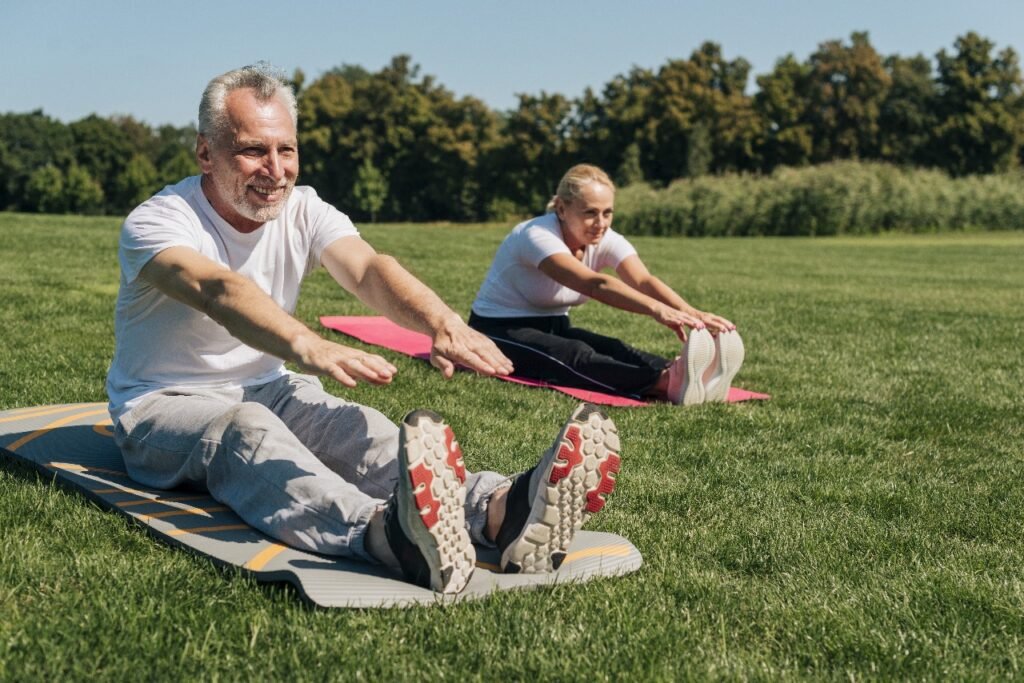
Aging is a natural part of life, but staying active as you grow older can dramatically improve your quality of life. Regular physical activity can help seniors maintain strength, mobility, independence, and overall health. Contrary to popular belief, you don’t need to be a gym enthusiast to stay fit in your senior years — simple, consistent movements can make a big difference.
This guide will walk you through the benefits of fitness for seniors, safe exercise routines, and helpful tips to stay motivated and injury-free.
Why Fitness Matters for Seniors
As we age, our body naturally loses muscle mass, bone density, balance, and flexibility. These changes increase the risk of falls, fractures, and chronic illnesses. However, regular exercise can slow down or even reverse many of these effects.
Key Benefits:
- Improved Heart Health: Cardio workouts keep the heart strong and blood pressure in check.
- Stronger Bones and Muscles: Weight-bearing and resistance exercises reduce the risk of osteoporosis and muscle loss.
- Better Balance and Flexibility: Prevent falls and improve mobility with stretching and coordination-based activities.
- Boosted Mood and Mental Health: Exercise releases endorphins, which help combat depression and anxiety.
- Enhanced Cognitive Function: Physical activity stimulates brain health and may delay cognitive decline.
- Chronic Disease Management: Helps manage conditions like diabetes, arthritis, and hypertension.
What Types of Exercise Are Best for Seniors?
Seniors should aim for a balanced fitness routine that includes four major components: endurance, strength, balance, and flexibility. Let’s break it down:
1. Endurance (Cardio)
These activities improve heart and lung health:
- Brisk walking
- Swimming
- Cycling (stationary or outdoor)
- Light dancing
- Low-impact aerobics
Start with: 10–15 minutes a day and gradually increase to 30 minutes, five days a week.
2. Strength Training
Maintaining muscle mass is key for daily activities like carrying groceries or standing up from a chair.
Try:
- Resistance bands
- Light dumbbells
- Bodyweight exercises (like wall push-ups or chair squats)
Frequency: 2–3 times a week
3. Balance Exercises
Falls are the leading cause of injury among older adults. These exercises help with stability:
- Standing on one foot (holding a chair for support)
- Heel-to-toe walk
- Tai Chi
- Gentle yoga poses like Tree Pose or Warrior III
Practice daily if possible.
4. Flexibility and Stretching
Keep joints healthy and improve mobility:
- Neck, shoulder, and leg stretches
- Gentle yoga or pilates
- Stretching after every workout
Tip: Hold each stretch for 15–30 seconds and never bounce.
How to Start a Safe Fitness Routine as a Senior
Before jumping into any new exercise plan, it’s important to be cautious.
Talk to Your Doctor:
- If you have chronic conditions (like heart disease or arthritis), consult a physician before starting.
- Ask if there are specific exercises you should avoid or emphasize.
Start Slow and Listen to Your Body:
- Begin with low-impact exercises and increase intensity gradually.
- Stop if you feel dizzy, short of breath, or in pain.
Choose Comfortable Clothing and Supportive Shoes:
- Proper footwear reduces strain on joints and prevents falls.
Stay Hydrated and Avoid Overexertion:
- Drink water before, during, and after exercise.
- Take breaks when needed.
Fitness at Home vs. Group Classes
Home Workouts:
Perfect for privacy, convenience, and flexibility. Use online videos tailored to seniors or try guided fitness apps.
Group Classes:
Social interaction can boost motivation and reduce isolation. Look for:
- Senior aerobics
- Chair yoga
- Aqua fitness
- Community center walking groups
Sample Weekly Fitness Plan for Seniors
| Day | Activity |
|---|---|
| Monday | 20-min walk + light stretching |
| Tuesday | Chair yoga + balance drills |
| Wednesday | Strength training (arms & legs) |
| Thursday | Rest or gentle stretching |
| Friday | Low-impact aerobics class |
| Saturday | Tai Chi + walk |
| Sunday | Rest or slow walk |
Staying Motivated as You Age
- Set small, realistic goals. Track your progress weekly.
- Exercise with a friend or spouse to make it enjoyable.
- Celebrate milestones, like being able to walk farther or lift heavier weights.
- Keep it fun — try dancing, gardening, or active games with grandkids.
Final Thoughts
Fitness isn’t about lifting heavy weights or running marathons. For seniors, it’s about maintaining the freedom to do what you love — walking in the park, playing with grandchildren, or simply climbing stairs without pain.
No matter your current fitness level, it’s never too late to start. Begin slowly, stay consistent, and choose activities you enjoy. Your future self will thank you.
